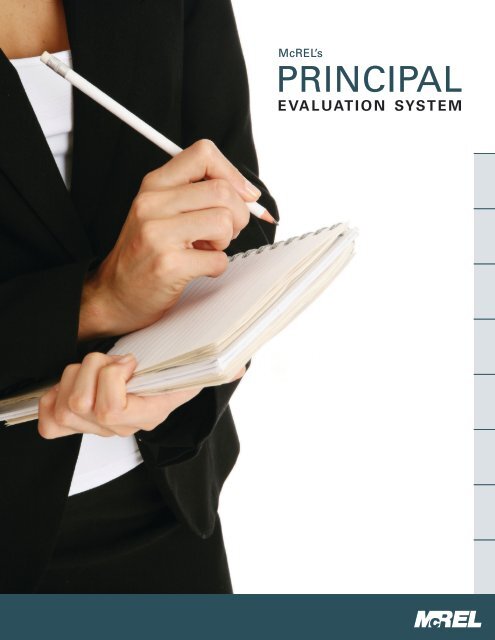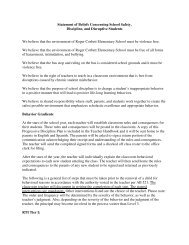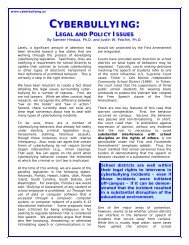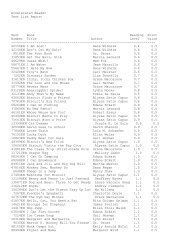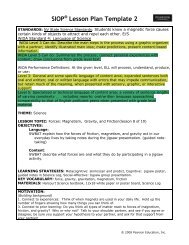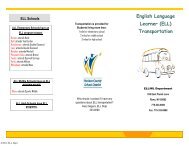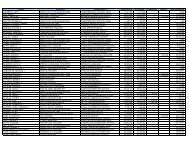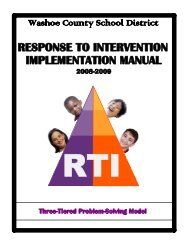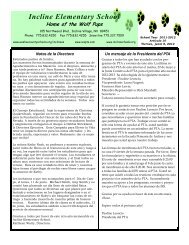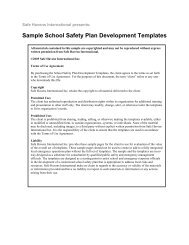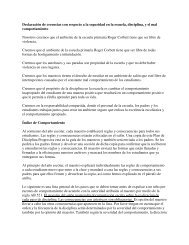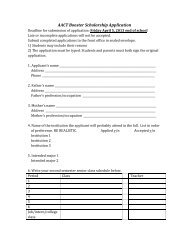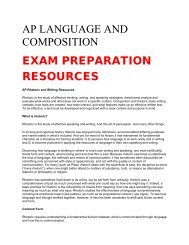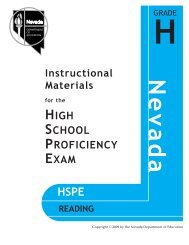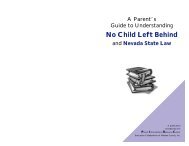McrEl's PrinciPal - Washoe County School District
McrEl's PrinciPal - Washoe County School District
McrEl's PrinciPal - Washoe County School District
You also want an ePaper? Increase the reach of your titles
YUMPU automatically turns print PDFs into web optimized ePapers that Google loves.
McREL’s<br />
Principal<br />
evaluation System
McREL’s Principal Evaluation System<br />
Rubric for Evaluating Principals and Self-Assessment Form (Required)<br />
This form must be completed by the principal as a part of the self-assessment process and by the superintendent/designee in<br />
preparation for the summary evaluation conference.<br />
Standard 1: Strategic Leadership<br />
Principals will create conditions that result in strategically re-imaging the school’s vision, mission, and goals in the 21 st century.<br />
Understanding that schools ideally prepare students for an unseen but not altogether unpredictable future, the leader creates<br />
a climate of inquiry that challenges the school community to continually re-purpose itself by building on its core values and<br />
beliefs about its preferred future and then developing a pathway to reach it.<br />
a. <strong>School</strong> Vision, Mission and Strategic Goals: The school’s identity, in part, is derived from the vision, mission, values, beliefs<br />
and goals of the school, the processes used to establish these attributes, and the ways they are embodied in the life of the school<br />
community.<br />
Developing Proficient Accomplished Distinguished<br />
Not Demonstrated<br />
(Comment Required)<br />
. . . and<br />
. . . and<br />
. . . and<br />
Develops his/her own<br />
vision of the changing<br />
world in the 21 st<br />
century that schools<br />
are preparing children<br />
to enter<br />
Leads and implements<br />
a process for developing<br />
a shared vision and<br />
strategic goals for<br />
student achievement<br />
that reflect high<br />
expectations for<br />
students and staff<br />
Maintains a focus on<br />
the vision and strategic<br />
goals throughout the<br />
school year<br />
Creates with<br />
stakeholders a vision for<br />
the school that captures<br />
peoples’ attention and<br />
imagination<br />
Designs and<br />
implements<br />
collaborative processes<br />
to collect and analyze<br />
data about the school’s<br />
progress for the periodic<br />
review and revision<br />
of the school’s vision,<br />
mission, and strategic<br />
goals<br />
Ensures that the<br />
school’s identity (vision,<br />
mission, values, beliefs<br />
and goals) actually drive<br />
decisions and inform<br />
the culture of the school<br />
Initiates changes to<br />
vision and goals based<br />
on data to improve<br />
performance, school<br />
culture and school<br />
success<br />
b. Leading Change: The principal articulates a vision, and implementation strategies, for improvements and changes which result in<br />
improved achievement for all students.<br />
. . . and<br />
. . . and<br />
. . . and<br />
Identifies changes<br />
necessary for the<br />
improvement of student<br />
learning<br />
Systematically considers<br />
new and better ways<br />
of leading for improved<br />
student achievement<br />
and engages<br />
stakeholders in the<br />
change process<br />
Adapts/varies leadership<br />
style according to the<br />
changing needs of the<br />
school and community<br />
Is comfortable with<br />
major changes<br />
in implementing<br />
processes and<br />
accomplishing tasks<br />
Is a driving force behind<br />
major initiatives that<br />
help students acquire<br />
21 st century skills<br />
Systematically<br />
challenges the status<br />
quo by leading change<br />
with potentially<br />
beneficial outcomes<br />
Routinely and<br />
systematically<br />
communicates the<br />
impacts of change<br />
processes to all<br />
stakeholders<br />
16
c. <strong>School</strong> Improvement Plan: The school improvement plan provides the structure for the vision, values, goals and changes<br />
necessary for improved achievement for all students.<br />
Developing Proficient Accomplished Distinguished<br />
Not Demonstrated<br />
(Comment Required)<br />
. . . and<br />
. . . . . . and<br />
. . . and<br />
Understands statutory<br />
requirements regarding<br />
the <strong>School</strong> Improvement<br />
Plan<br />
Facilitates the<br />
collaborative<br />
development of<br />
the annual <strong>School</strong><br />
Improvement Plan to<br />
realize strategic goals<br />
and objectives<br />
Facilitates the<br />
successful execution of<br />
the <strong>School</strong> Improvement<br />
Plan aligned to the<br />
mission and goals set<br />
by the State Board of<br />
Education, the local<br />
Board of Education<br />
Incorporates principles<br />
of continuous<br />
improvement<br />
and creative 21 st<br />
century concepts for<br />
improvement into the<br />
<strong>School</strong> Improvement<br />
Plan<br />
Systematically collects,<br />
analyzes, and uses data<br />
regarding the school’s<br />
progress toward<br />
attaining strategic goals<br />
and objectives<br />
d. Distributive Leadership: The principal creates and utilizes processes to distribute leadership and<br />
decision making throughout the school.<br />
. . . and<br />
. . . and<br />
. . . and<br />
Seeks input from a<br />
variety of stakeholder<br />
groups, including<br />
teachers and parents/<br />
guardians<br />
Understands the<br />
importance of providing<br />
opportunities for<br />
teachers to assume<br />
leadership and decisionmaking<br />
roles within the<br />
school<br />
Involves parents/<br />
guardians, the<br />
community, and<br />
staff members in<br />
decisions about school<br />
governance, curriculum<br />
and instruction.<br />
Provides leadership<br />
development activities<br />
for staff members<br />
Ensures that parents/<br />
guardians, community<br />
members and staff<br />
members have<br />
autonomy to make<br />
decisions and supports<br />
the decisions made as<br />
a part of the collective<br />
decision-making<br />
process<br />
Creates opportunities<br />
for staff to demonstrate<br />
leadership skills by<br />
allowing them to<br />
assume leadership and<br />
decision-making roles<br />
Encourages staff<br />
members to<br />
accept leadership<br />
responsibilities outside<br />
of the school building<br />
Incorporates teachers<br />
and support staff<br />
into leadership and<br />
decision-making<br />
roles in the school in<br />
ways that foster the<br />
career development of<br />
participating teachers<br />
Comments<br />
17
McREL’s Principal Evaluation System<br />
Examples of Artifacts:<br />
<strong>School</strong> Improvement Plan<br />
Evidence of <strong>School</strong> Improvement Team<br />
Student achievement and testing data<br />
Statement of school vision, mission, values, beliefs and goals<br />
Evidence of stakeholder involvement in development of vision, mission,<br />
value, belief and goal statements<br />
Evidence of shared decision making and distributed leadership<br />
____________________________________________<br />
____________________________________________<br />
____________________________________________<br />
____________________________________________<br />
Standard 2: Instructional Leadership<br />
Principals set high standards for the professional practice of 21 st century instruction and assessment that result in a no-nonsense<br />
accountable environment. They must be knowledgeable of best instructional and school practices and must use this knowledge to cause<br />
the creation of collaborative structures within the school for the design of highly engaging schoolwork for students, the on-going peer<br />
review of this work, and the sharing of this work throughout the professional community.<br />
a. Focus on Learning and Teaching, Curriculum, Instruction and Assessment: The principal leads the discussion about standards<br />
for curriculum, instruction and assessment based on research and best practices in order to establish and achieve high expectations<br />
for students.<br />
Developing Proficient Accomplished Distinguished<br />
Not Demonstrated<br />
(Comment Required)<br />
. . . and<br />
. . . and<br />
. . . and<br />
Collects and analyzes<br />
student assessment<br />
data in adherence with<br />
instructional and legal<br />
requirements<br />
Provides students<br />
access to a variety<br />
of 21 st century<br />
instructional tools,<br />
including technology<br />
Systematically focuses on<br />
the alignment of learning,<br />
teaching, curriculum,<br />
instruction, and assessment<br />
to maximize student<br />
learning<br />
Organizes targeted<br />
opportunities for teachers<br />
to learn how to teach their<br />
subjects well<br />
Ensures that students are<br />
provided opportunities<br />
to learn and utilize<br />
best practices in the<br />
integrated use of 21 st<br />
century instructional tools,<br />
including technology, to<br />
solve problems<br />
Ensures that the<br />
alignment of learning,<br />
teaching, curriculum,<br />
instruction, and<br />
assessment is focused<br />
to maximize student<br />
learning<br />
Creates a culture that it<br />
is the responsibility of<br />
all staff to make sure<br />
that all students are<br />
successful<br />
Ensures that knowledge<br />
of teaching and<br />
learning serves as<br />
the foundation for the<br />
school’s professional<br />
learning community<br />
Encourages and<br />
challenges staff to<br />
reflect deeply on,<br />
and define, what<br />
knowledge, skills<br />
and concepts are<br />
essential to the<br />
complete educational<br />
development of<br />
students<br />
b. Focus on Instructional Time: The principal creates processes and schedules which protect teachers from disruption of<br />
instructional or preparation time.<br />
. . . and<br />
. . . and<br />
. . . and<br />
Understands the need<br />
for teachers to have<br />
daily planning time and<br />
duty-free lunch periods<br />
Is knowledgeable<br />
of designs for ageappropriate<br />
school<br />
schedules which<br />
address the learning<br />
needs of diverse<br />
student populations<br />
Adheres to legal<br />
requirements for planning<br />
and instructional time<br />
Develops a master<br />
schedule to maximize<br />
student learning by<br />
providing for individual<br />
and on-going collaborative<br />
planning for every teacher<br />
Designs scheduling<br />
processes and protocols<br />
that maximize staff input<br />
and address diverse<br />
student learning needs<br />
Ensures that teachers<br />
have the legally required<br />
amount of daily planning<br />
and lunch periods<br />
Routinely and<br />
conscientiously<br />
implements processes<br />
to protect instructional<br />
time from interruptions<br />
Structures the school<br />
schedule to enable all<br />
teachers to have individual<br />
and team collaborative<br />
planning time<br />
Systematically monitors<br />
the effect of the master<br />
schedule on collaborative<br />
planning and student<br />
achievement<br />
Ensures that district<br />
leadership is informed<br />
of the amounts and<br />
scheduling of individual<br />
and team planning time<br />
18
Comments<br />
Examples of Artifacts:<br />
<strong>School</strong> Improvement Plan<br />
Student achievement and testing data<br />
Student drop-out data<br />
Documented use of formative assessment instruments to impact<br />
instruction<br />
Development and communication of goal-oriented personalized<br />
education plans for identified students<br />
Evidence of team development and evaluation of classroom lessons<br />
Use of research-based practices and strategies in classrooms<br />
Master school schedule documenting individual and collaborative<br />
planning for every teacher<br />
____________________________________________<br />
____________________________________________<br />
____________________________________________<br />
Standard 3: Cultural Leadership<br />
Principals will understand and act on the understanding of the important role a school’s culture plays in contributing to the<br />
exemplary performance of the school. Principals must support and value the traditions, artifacts, symbols and positive values<br />
and norms of the school and community that result in a sense of identity and pride upon which to build a positive future.<br />
A principal must be able to “re-culture” the school if needed to align with school’s goals of improving student and adult<br />
learning and to infuse the work of the adults and students with passion, meaning and purpose. Cultural leadership implies<br />
understanding the school and the people in it each day, how they came to their current state, and how to connect with their<br />
traditions in order to move them forward to support the school’s efforts to achieve individual and collective goals.<br />
a. Focus on Collaborative Work Environment: The principal understands and acts on the understanding of the positive role that a<br />
collaborative work environment can play in the school’s culture.<br />
Developing Proficient Accomplished Distinguished<br />
Not Demonstrated<br />
(Comment Required)<br />
. . . and<br />
. . . and<br />
. . . and<br />
Understands<br />
characteristics of a<br />
collaborative work<br />
environment within the<br />
school<br />
Understands the<br />
importance of data<br />
gained from the Teacher<br />
Working Conditions<br />
Survey and other data<br />
sources from parents,<br />
students, teachers and<br />
stakeholders that reflect<br />
on the teaching and<br />
learning environment<br />
within the school.<br />
Designs elements<br />
of a collaborative<br />
and positive work<br />
environment within the<br />
school<br />
Participates in and<br />
relies upon the <strong>School</strong><br />
Improvement Team and<br />
other stakeholder voices<br />
to make decisions about<br />
school policies<br />
Utilizes data gained<br />
from the Teacher<br />
Working Conditions<br />
Survey and other<br />
sources to understand<br />
perceptions of the work<br />
environment<br />
Utilizes a collaborative<br />
work environment<br />
predicated on sitebased<br />
management<br />
and decision making,<br />
a sense of community,<br />
and cooperation within<br />
the school<br />
Monitors the<br />
implementation and<br />
response to school<br />
policies and provides<br />
feedback to the <strong>School</strong><br />
Improvement Team for<br />
their consideration<br />
Initiates changes<br />
resulting from data<br />
gained from the Teacher<br />
Working Conditions<br />
Survey and other<br />
sources<br />
Establishes a<br />
collaborative work<br />
environment which<br />
promotes cohesion and<br />
cooperation among staff<br />
Facilitates the<br />
collaborative (team)<br />
design, sharing,<br />
evaluation, and<br />
archiving of rigorous,<br />
relevant, and engaging<br />
instructional lessons<br />
that ensure students<br />
acquire essential<br />
knowledge and skills<br />
19
McREL’s Principal Evaluation System<br />
b. <strong>School</strong> Culture and Identity: The principal develops and uses shared vision, values and goals to define the identity and culture of<br />
the school.<br />
Developing Proficient Accomplished Distinguished<br />
Not Demonstrated<br />
(Comment Required)<br />
. . . and<br />
. . . and<br />
. . . and<br />
Understands the<br />
importance of<br />
developing a shared<br />
vision, mission, values,<br />
beliefs and goals to<br />
establish a school<br />
culture and identity<br />
Systematically develops<br />
and uses shared values,<br />
beliefs and a shared<br />
vision to establish a<br />
school culture and<br />
identity<br />
Establishes a culture<br />
of collaboration,<br />
distributed leadership<br />
and continuous<br />
improvement in the<br />
school which guides the<br />
disciplined thought and<br />
action of all staff and<br />
students<br />
Ensures that the<br />
school’s identity and<br />
changing culture (vision,<br />
mission, values, beliefs<br />
and goals) actually<br />
drives decisions and<br />
informs the culture of<br />
the school<br />
c. Acknowledges Failures; Celebrates Accomplishments and Rewards: The principal acknowledges failures and<br />
celebrates accomplishments of the school in order to define the identity, culture and performance of the school.<br />
. . . and<br />
. . . and<br />
. . . and<br />
Recognizes the<br />
importance of<br />
acknowledging failures<br />
and celebrating<br />
accomplishments of the<br />
school and staff<br />
Uses established<br />
criteria for performance<br />
as the primary basis<br />
for reward and<br />
advancement<br />
Systematically<br />
recognizes individuals<br />
for reward and<br />
advancement based on<br />
established criteria<br />
Recognizes individual<br />
and collective<br />
contributions toward<br />
attainment of strategic<br />
goals<br />
Utilizes recognition,<br />
reward, and<br />
advancement as a<br />
way to promote the<br />
accomplishments of the<br />
school<br />
Utilizes recognition of<br />
failure as an opportunity<br />
to improve<br />
d. Efficacy and Empowerment: The principal develops a sense of efficacy and empowerment among staff which influences the<br />
school’s identity, culture and performance.<br />
Understands the<br />
importance of building<br />
a sense of efficacy and<br />
empowerment among<br />
staff<br />
Understands the<br />
importance of<br />
developing a sense of<br />
well-being among staff,<br />
students and parents/<br />
guardians<br />
. . . and<br />
Identifies strategies<br />
for building a sense<br />
of efficacy and<br />
empowerment among<br />
staff<br />
Identifies strategies for<br />
developing a sense of<br />
well-being among staff,<br />
students and parents/<br />
guardians<br />
. . . and<br />
Utilizes a variety<br />
of activities, tools<br />
and protocols to<br />
develop efficacy and<br />
empowerment among<br />
staff<br />
Actively models and<br />
promotes a sense of<br />
well-being among staff,<br />
students and parents/<br />
guardians<br />
. . . and<br />
Builds a sense<br />
of efficacy and<br />
empowerment among<br />
staff that results in<br />
increased capacity to<br />
accomplish substantial<br />
outcomes<br />
Utilizes a collective<br />
sense of well-being<br />
among staff, students<br />
and parents/guardians<br />
to impact student<br />
achievement<br />
Comments<br />
20
Examples of Artifacts:<br />
<strong>School</strong> Improvement Plan<br />
<strong>School</strong> Improvement Team<br />
Evidence of shared decision making and distributed leadership<br />
Recognition criteria and structure utilized<br />
Documented use of <strong>School</strong> Improvement Team in decision making<br />
Student achievement and testing data<br />
Existence and work of professional learning communities<br />
Teacher retention data<br />
____________________________________________<br />
____________________________________________<br />
____________________________________________<br />
Standard 4: Human Resource Leadership<br />
Principals will ensure that the school is a professional learning community. Principals will ensure that process and systems are<br />
in place which results in recruitment, induction, support, evaluation, development and retention of high performing staff. The<br />
principal must engage and empower accomplished teachers in a distributive manner, including support of teachers in day-today<br />
decisions such as discipline, communication with parents/guardians, and protecting teachers from duties that interfere<br />
with teaching, and must practice fair and consistent evaluations of teachers. The principal must engage teachers and other<br />
professional staff in conversations to plan their career paths and support district succession planning.<br />
a. Professional Development/Learning Communities: The principal ensures that the school is a professional learning community.<br />
Developing Proficient Accomplished Distinguished<br />
Not Demonstrated<br />
(Comment Required)<br />
. . . and<br />
. . . and<br />
. . . and<br />
Understands the<br />
importance of<br />
developing effective<br />
professional learning<br />
communities and<br />
results-oriented<br />
professional<br />
development<br />
Understands the<br />
importance of continued<br />
personal learning<br />
and professional<br />
development<br />
Provides structures<br />
for, and implements<br />
the development of<br />
effective professional<br />
learning communities<br />
and results-oriented<br />
professional<br />
development<br />
Routinely participates<br />
in professional<br />
development<br />
focused on improving<br />
instructional programs<br />
and practices<br />
Facilitates opportunities<br />
for effective professional<br />
learning communities<br />
aligned with the school<br />
improvement plan,<br />
focused on results,<br />
and characterized by<br />
collective responsibility<br />
for instructional planning<br />
and student learning<br />
Ensures that<br />
professional<br />
development within the<br />
school is aligned with<br />
curricular, instructional,<br />
and assessment needs,<br />
while recognizing the<br />
unique professional<br />
development needs of<br />
individual staff members<br />
b. Recruiting, Hiring, Placing and Mentoring of staff: The principal establishes processes and systems in order to ensure a highquality,<br />
high-performing staff.<br />
. . . and<br />
. . . and<br />
. . . and<br />
Understands the<br />
school’s need to recruit,<br />
hire, appropriately place,<br />
and mentor new staff<br />
members<br />
At the school level, creates<br />
and implements processes<br />
for:<br />
Recruiting new teachers<br />
and staff<br />
Hiring new teachers and<br />
staff<br />
Placing new teachers<br />
and staff<br />
Mentoring new teachers<br />
and staff<br />
Supports, mentors<br />
and coaches staff<br />
members who are new<br />
or emerging leaders or<br />
who need additional<br />
support<br />
Continuously<br />
searches for staff with<br />
outstanding potential as<br />
educators and provides<br />
the best placement of<br />
both new and existing<br />
staff to fully benefit<br />
from their strengths<br />
in meeting the needs<br />
of a diverse student<br />
population<br />
Ensures that<br />
professional<br />
development is available<br />
for staff members with<br />
potential to serve as<br />
mentors and coaches<br />
21
McREL’s Principal Evaluation System<br />
c. Teacher and Staff Evaluation: The principal evaluates teachers and other staff in a fair and equitable manner with the focus on<br />
improving performance and, thus, student achievement.<br />
Developing Proficient Accomplished Distinguished<br />
Not Demonstrated<br />
(Comment Required)<br />
. . . and<br />
. . . and<br />
. . . and<br />
Adheres to legal<br />
requirements for<br />
teacher and staff<br />
evaluation<br />
Creates processes to<br />
provide formal feedback<br />
to teachers concerning<br />
the effectiveness<br />
of their classroom<br />
instruction and ways<br />
to improve their<br />
instructional practice<br />
Implements district and<br />
state evaluation policies<br />
in a fair and equitable<br />
manner<br />
Utilizes multiple<br />
assessments to<br />
evaluate teachers and<br />
other staff members<br />
Evaluates teachers and<br />
other staff in a fair and<br />
equitable manner and<br />
utilizes the results of<br />
evaluations to improve<br />
instructional practice<br />
Analyzes the results<br />
of teacher and staff<br />
evaluations holistically<br />
and utilizes the results<br />
to direct professional<br />
development<br />
opportunities in the<br />
school<br />
Comments<br />
Examples of Artifacts:<br />
<strong>School</strong> Improvement Plan<br />
Student achievement and testing data<br />
Teacher retention data<br />
National Board Certification<br />
Teacher professional growth plans<br />
Master school schedule documenting individual and collaborative planning<br />
for every teacher<br />
Number of National Board Certified Teachers<br />
Number of teachers pursuing advanced degrees<br />
Record of professional development provided staff<br />
Impact of professional development on student learning<br />
Mentor records and beginning teacher feedback<br />
____________________________________________<br />
____________________________________________<br />
____________________________________________<br />
22
Standard 5: Managerial Leadership<br />
Principals will ensure that the school has processes and systems in place for budgeting, staffing, problem solving,<br />
communicating expectations and scheduling that result in organizing the work routines in the building. The principal must be<br />
responsible for the monitoring of the school budget and the inclusion of all teachers in the budget decision so as to meet the<br />
21 st century needs of every classroom. Effectively and efficiently managing the complexity of everyday life is critical for staff<br />
to be able to focus its energy on improvement.<br />
a. <strong>School</strong> Resources and Budget: The principal establishes budget processes and systems which are focused on, and result in,<br />
improved student achievement.<br />
Developing Proficient Accomplished Distinguished<br />
Not Demonstrated<br />
(Comment Required)<br />
. . . and<br />
. . . and<br />
. . . and<br />
Is knowledgeable of<br />
school budget and<br />
accounting procedures<br />
Utilizes input from staff<br />
to establish funding<br />
priorities and a balanced<br />
operational budget for<br />
school programs and<br />
activities<br />
Incorporates the input of<br />
the <strong>School</strong> Improvement<br />
Team in budget and<br />
resource decisions<br />
Uses feedback and data<br />
to assess the success<br />
of funding and program<br />
decisions<br />
Designs transparent<br />
systems to equitably<br />
manage human and<br />
financial resources<br />
Ensures the strategic<br />
allocation and equitable<br />
use of financial<br />
resources to meet<br />
instructional goals and<br />
support teacher needs<br />
b. Conflict Management and Resolution: The principal effectively and efficiently manages the complexity of human interactions so<br />
that the focus of the school can be on improved student achievement.<br />
. . . and<br />
. . . and<br />
. . . and<br />
Demonstrates<br />
awareness of potential<br />
problems and/or areas<br />
of conflict within the<br />
school<br />
Creates processes to<br />
resolve problems and/or<br />
areas of conflict within<br />
the school<br />
Resolves school-based<br />
problems/conflicts in a fair,<br />
democratic way<br />
Provides opportunities for<br />
staff members to express<br />
opinions contrary to those<br />
of authority or in relation<br />
to potentially discordant<br />
issues<br />
Discusses with staff and<br />
implements solutions<br />
to address potentially<br />
discordant issues<br />
Monitors staff response<br />
to discussions about<br />
solutions to potentially<br />
discordant issues to<br />
ensure that all interests<br />
are heard and respected<br />
Resolves conflicts to<br />
ensure the best interest<br />
of students and the<br />
school result<br />
c. Systematic Communication: The principal designs and utilizes various forms of formal and informal communication so that the<br />
focus of the school can be on improved student achievement.<br />
. . . and<br />
. . . and<br />
. . . and<br />
Understands the<br />
importance of open,<br />
effective communication<br />
in the operation of the<br />
school<br />
Designs a system of<br />
open communication<br />
that provides for the<br />
timely, responsible<br />
sharing of information<br />
to, from, and with the<br />
school community<br />
Routinely involves the<br />
school improvement<br />
team in school wide<br />
communications<br />
processes<br />
Utilizes a system of open<br />
communication that<br />
provides for the timely,<br />
responsible sharing of<br />
information within the<br />
school community<br />
Provides information<br />
in different formats in<br />
multiple ways through<br />
different media in order to<br />
ensure communication<br />
with all members of the<br />
community<br />
Ensures that<br />
all community<br />
stakeholders and<br />
educators are aware<br />
of school goals<br />
for instruction and<br />
achievement, activities<br />
used to meet these<br />
goals, and progress<br />
toward meeting these<br />
goals<br />
23
McREL’s Principal Evaluation System<br />
d. <strong>School</strong> Expectations for Students and Staff: The principal develops and enforces expectations, structures, rules and procedures<br />
for students and staff.<br />
Developing Proficient Accomplished Distinguished<br />
Not Demonstrated<br />
(Comment Required)<br />
. . . and<br />
. . . and<br />
. . . and<br />
Understands the<br />
importance of<br />
clear expectations,<br />
structures, rules and<br />
procedures for students<br />
and staff<br />
Understands district<br />
and state policy and<br />
law related to student<br />
conduct, etc.<br />
Collaboratively develops<br />
clear expectations,<br />
structures, rules and<br />
procedures for students<br />
and staff through the<br />
<strong>School</strong> Improvement<br />
Team<br />
Effectively implements<br />
district rules and<br />
procedures<br />
Communicates<br />
and enforces clear<br />
expectations,<br />
structures, and fair rules<br />
and procedures for<br />
students and staff<br />
Systematically<br />
monitors issues<br />
around compliance<br />
with expectations,<br />
structures, rules and<br />
expectations. Utilizes<br />
staff and student input<br />
to resolve such issues<br />
Regularly reviews<br />
the need for changes<br />
to expectations,<br />
structures, rules and<br />
expectations<br />
Comments<br />
Examples of Artifacts:<br />
<strong>School</strong> Improvement Plan<br />
<strong>School</strong> financial information<br />
<strong>School</strong> safety and behavioral expectations<br />
Master school schedule documenting individual and collaborative planning<br />
for every teacher<br />
Evidence of formal and informal systems of communication<br />
Dissemination of clear norms and ground rules<br />
Evidence of ability to confront ideological conflict and then<br />
reach consensus<br />
____________________________________________<br />
____________________________________________<br />
____________________________________________<br />
24
Standard 6: External Development Leadership<br />
Principals will design structures and processes that result in community engagement, support, and ownership. Acknowledging<br />
that schools no longer reflect but, in fact, build community, the leader proactively creates with staff, opportunities for<br />
parents/guardians, community and business representatives to participate as “stockholders” in the school such that continued<br />
investment of resources and good will are not left to chance.<br />
a. Parent and Community Involvement and Outreach: The principal designs structures and processes which result in parent and<br />
community engagement, support and ownership for the school.<br />
Developing Proficient Accomplished Distinguished<br />
Interacts with, and<br />
acknowledges that<br />
parents/guardians and<br />
community members<br />
have a critical role in<br />
developing community<br />
engagement, support<br />
and ownership of the<br />
school<br />
Identifies the positive,<br />
culturally-responsive<br />
traditions of the school<br />
and community<br />
. . . and<br />
Proactively creates<br />
systems that engage<br />
parents/ guardians<br />
and all community<br />
stakeholders in a<br />
shared responsibility<br />
for student and school<br />
success reflecting the<br />
community’s vision of<br />
the school<br />
. . . and<br />
Implements processes<br />
that empower<br />
parents/guardians<br />
and all community<br />
stakeholders to make<br />
significant decisions<br />
. . . and<br />
Proactively develops<br />
relationships with<br />
parents/guardians and<br />
the community so as to<br />
develop good will and<br />
garner fiscal, intellectual<br />
and human resources<br />
that support specific<br />
aspects of the school’s<br />
learning agenda<br />
Not Demonstrated<br />
(Comment Required)<br />
b. Federal, State and <strong>District</strong> Mandates: The principal designs protocols and processes in order to comply with federal, state, and<br />
district mandates.<br />
Is knowledgeable of<br />
applicable federal, state<br />
and district mandates<br />
Is aware of district goals<br />
and initiatives directed<br />
at improving student<br />
achievement<br />
. . . and<br />
Designs protocols and<br />
processes to comply<br />
with federal, state and<br />
district mandates<br />
Implements district<br />
initiatives directed<br />
at improving student<br />
achievement<br />
. . . and<br />
Ensures compliance with<br />
federal, state and district<br />
mandates<br />
Continually assesses<br />
the progress of district<br />
initiatives and reports<br />
results to district-level<br />
decision makers.<br />
. . . and<br />
Interprets federal,<br />
state and district<br />
mandates for the school<br />
community so that such<br />
mandates are viewed<br />
as an opportunity for<br />
improvement within the<br />
school<br />
Actively participates<br />
in the development<br />
of district goals and<br />
initiatives directed<br />
at improving student<br />
achievement<br />
Comments<br />
25
McREL’s Principal Evaluation System<br />
Examples of Artifacts:<br />
Parent involvement in <strong>School</strong> Improvement Team<br />
PTSA/Booster club operation and participation<br />
Parent survey results<br />
Evidence of business partners and projects involving business<br />
partners<br />
Plan for shaping the school’s image throughout the community<br />
Evidence of community support<br />
Number and use of school volunteers<br />
____________________________________________<br />
____________________________________________<br />
____________________________________________<br />
Standard 7: Micro-political Leadership<br />
Principals will build systems and relationships that utilize the staff ’s diversity, encourage constructive ideological conflict in<br />
order to leverage staff expertise, power and influence in order to realize the school’s vision for success. The principal will also<br />
creatively employ an awareness of staff ’s professional needs, issues, and interests to build cohesion and to facilitate distributed<br />
governance and shared decision making.<br />
<strong>School</strong> Executive Micro-political Leadership: The principal develops systems and relationships to leverage staff expertise and<br />
influence in order to influence the school’s identity, culture and performance.<br />
Developing Proficient Accomplished Distinguished<br />
Not Demonstrated<br />
(Comment Required)<br />
. . . and<br />
. . . and<br />
. . . and<br />
<br />
Maintains high visibility<br />
and is easily accessible<br />
throughout the school<br />
Is aware of the<br />
expertise, power<br />
and influence of<br />
staff members, and<br />
demonstrates sensitivity<br />
to their personal and<br />
professional needs<br />
Builds systems and<br />
relationships that utilize<br />
the staff’s diversity,<br />
ideological differences<br />
and expertise to realize<br />
the school’s goals<br />
Creatively employs an<br />
awareness of staff’s<br />
professional needs,<br />
issues and interests<br />
to build cohesion and<br />
to facilitate distributed<br />
governance and shared<br />
decision-making<br />
Comments<br />
Examples of Artifacts:<br />
Teacher retention data<br />
Evidence of visibility and accessibility<br />
Evidence of shared decision making and distributed leadership<br />
____________________________________________<br />
____________________________________________<br />
____________________________________________<br />
26
McREL’s Principal Evaluation System<br />
Principal Summary Evaluation Rating Form (Required)<br />
This form is to be jointly completed by the principal and superintendent/designee during the summary Evaluation Conference<br />
conducted at the end of the year.<br />
Name:_ ___________________________________________________________________________________________<br />
<strong>School</strong>: _ ___________________________________________________ <strong>School</strong> Year:_____________________________<br />
Evaluator: __________________________________________________ <strong>District</strong>:________________________________<br />
Date Completed:_____________________________________________ Evaluator’s Title:_ ________________________<br />
Standard 1: Strategic Leadership<br />
Elements Developing Proficient Accomplished Distinguished<br />
A. <strong>School</strong> Vision, Mission and Strategic Goals: The school’s identity, in part, is derived<br />
from the vision, mission, values, beliefs and goals of the school, the processes used to establish<br />
these attributes, and the ways they are embodied in the life of the school community.<br />
B. Leading Change: The principal articulates a vision and implementation strategies for<br />
improvements and changes which result in improved achievement for all students.<br />
C. <strong>School</strong> Improvement Plan: The school improvement plan provides the structure for the<br />
vision, values, goals and changes necessary for improved achievement for all students.<br />
D. Distributive Leadership: The principal creates and utilizes processes to distribute leadership<br />
and decision making throughout the school.<br />
Overall Rating for Standard 1<br />
Not<br />
Demonstrated<br />
Comments:<br />
Recommended actions for improvement:<br />
Evidence or documentation to support rating:<br />
___ <strong>School</strong> Improvement Plan.<br />
___ Evidence of <strong>School</strong> Improvement Team.<br />
___ Student achievement and testing data.<br />
___ Statement of school vision, mission, values, beliefs and goals.<br />
___ Evidence of stakeholder involvement in development of<br />
vision, mission, value, belief and goal statements.<br />
___ Evidence of shared decision making and distributed leadership.<br />
___ 360 Feedback.<br />
___ _________________________________________________<br />
___ _________________________________________________<br />
___ _________________________________________________<br />
Resources needed to complete these actions:<br />
32
Standard 2: Instructional Leadership<br />
Elements Developing Proficient Accomplished Distinguished<br />
A. Focus on Learning and Teaching, Curriculum, Instruction and Assessment: The<br />
principal leads the discussion about standards for curriculum, instruction and assessment<br />
based on research and best practices in order to establish and achieve high expectations for<br />
students.<br />
B. Focus on Instructional Time: The principal creates processes and schedules which<br />
protect teachers form disruption of instructional or preparation time.<br />
Overall Rating for Standard 2<br />
Not<br />
Demonstrated<br />
Comments:<br />
Recommended actions for improvement:<br />
Evidence or documentation to support rating:<br />
___ <strong>School</strong> Improvement Plan.<br />
___ Student achievement and testing data.<br />
___ Student drop-out data.<br />
___ Teacher retention data.<br />
___ Documented use of formative assessment instruments<br />
to impact instruction.<br />
___ Development and communication of goal-oriented<br />
personalized education plans for identified students.<br />
___ Evidence of team development and evaluation of classroom<br />
lessons.<br />
___ Use of research-based practices and strategies in<br />
classrooms.<br />
___ Master school schedule documenting individual and<br />
collaborative planning for every teacher..<br />
___ 360 Feedback.<br />
___ _________________________________________________<br />
___ _________________________________________________<br />
___ _________________________________________________<br />
Resources needed to complete these actions:<br />
33
McREL’s Principal Evaluation System<br />
Standard 3: Cultural Leadership<br />
Elements Developing Proficient Accomplished Distinguished<br />
A. Focus on Collaborative Work Environment: The principal understands and acts on the<br />
understanding of the positive role that a collaborative environment can play in the school's<br />
culture.<br />
B. <strong>School</strong> Culture and Identity: The principal develops and uses shared vision, values and<br />
goals to define the identity and culture of the school.<br />
C. Acknowledges Failures; Celebrates Accomplishments and Rewards: The principal<br />
acknowledges failures and celebrates accomplishments of the school in order to define the<br />
identity, culture and performance of the school.<br />
D. Efficacy and Empowerment: The principal develops a sense of efficacy and<br />
empowerment among staff which influences the school's identity, culture and performance.<br />
Overall Rating for Standard 3<br />
Not<br />
Demonstrated<br />
Comments:<br />
Recommended actions for improvement:<br />
Evidence or documentation to support rating:<br />
___ <strong>School</strong> Improvement Plan.<br />
___ <strong>School</strong> Improvement Team.<br />
___ Documented use of <strong>School</strong> Improvement Team in decisionmaking.<br />
___ Student achievement and testing data.<br />
___ Teacher retention data.<br />
___ Existence and work of professional learning communities.<br />
___ Recognition criteria and structure utilized.<br />
___ Evidence of shared decision-making and distributed leadership.<br />
___ 360 Feedback.<br />
___ _________________________________________________<br />
___ _________________________________________________<br />
___ _________________________________________________<br />
Resources needed to complete these actions:<br />
34
Standard 4: Human Resources Leadership<br />
Elements Developing Proficient Accomplished Distinguished<br />
A. Professional Development/Learning Communities: The principal ensures that the<br />
school is a professional learning community.<br />
B. Recruiting, hiring, Placing and Mentoring of Staff: The principal establishes<br />
processes and systems in order to ensure a high-quality, high-performing staff.<br />
C. Teacher and Staff Evaluation: The principal evaluates teachers and other staff in a<br />
fair and equitable manner with the focus on improving performance and, thus, student<br />
achievement.<br />
Overall Rating for Standard 4<br />
Not<br />
Demonstrated<br />
Note: If the school’s teacher turnover rate, according to the school report card, is above the state average and/or identified as a problem in the<br />
school improvement plan, it must be addressed here along with recommendations for improvement. If the turnover is equal to or lower than the<br />
state average, the principal must set a goal to at least maintain that rate.<br />
<strong>School</strong>’s Teacher Turnover Rate during previous school year: ____________<br />
<strong>School</strong>’s Teacher Turnover Rate for current school year: ____________<br />
State’s Teacher Turnover Rate for current school year: ____________<br />
Teacher Turnover Rate goal for next school year:<br />
____________<br />
Recommendations to achieve teacher turnover goal for next school year:<br />
Comments:<br />
Recommended actions for improvement:<br />
Resources needed to complete these actions:<br />
Evidence or documentation to support rating:<br />
___ <strong>School</strong> Improvement Plan.<br />
___ Student Achievement and testing data.<br />
___ Teacher retention data.<br />
___ Master school schedule documenting individual and collaborative<br />
planning for every teacher.<br />
___ Number of National Board Certified Teachers.<br />
___ Number of teachers pursuing advanced degrees, licensure,<br />
National Board certification etc.<br />
___ Record of professional development provided staff and impact of<br />
professional development on student learning.<br />
___ Mentor records and beginning teacher feedback.<br />
___ Teacher professional growth plans.<br />
___ 360 Feedback.<br />
___ _________________________________________________<br />
___ _________________________________________________<br />
___ _________________________________________________<br />
35
McREL’s Principal Evaluation System<br />
Standard 5: Managerial Leadership<br />
Elements Developing Proficient Accomplished Distinguished<br />
A. <strong>School</strong> Resources and Budget: The principal establishes budget processes and<br />
systems which are focused on, and result in, improved student achievement.<br />
B. Conflict management and Resolution: The principal effectively and efficiently<br />
manages the complexity of human interactions so that the focus of the school can be on<br />
improved student achievement.<br />
C. Systematic Communication: The principal designs and utilizes various forms of<br />
formal and informal communication so that the focus of the school can be on improved<br />
student achievement.<br />
D. <strong>School</strong> Expectations for Students and Staff: The principal develops and enforces<br />
expectations, structures, rules and procedures for students and staff.<br />
Overall Rating for Standard 5<br />
Not<br />
Demonstrated<br />
Comments:<br />
Recommended actions for improvement:<br />
Evidence or documentation to support rating:<br />
___ <strong>School</strong> Improvement Plan.<br />
___ Master school schedule documenting individual and collaborative<br />
planning for every teacher.<br />
___ <strong>School</strong> safety and behavioral Expectations.<br />
___ <strong>School</strong> financial information.<br />
___ Dissemination of clear norms and ground rules.<br />
___ Evidence of ability to confront ideological conflict and then reach<br />
consensus.<br />
___ Evidence of formal and informal systems of communication.<br />
___ 360 Feedback.<br />
___ _________________________________________________<br />
___ _________________________________________________<br />
___ _________________________________________________<br />
Resources needed to complete these actions:<br />
36
Standard 6: External Development Leadership<br />
Elements Developing Proficient Accomplished Distinguished<br />
A. Parent and Community Involvement and Outreach: The principal designs<br />
structures and processes which result in parent and community engagement, support<br />
and ownership for the school.<br />
B. Federal, State and <strong>District</strong> mandates: The principal designs protocols and<br />
processes in order to comply with federal, state and district mandates.<br />
Overall Rating for Standard 6<br />
Not<br />
Demonstrated<br />
Comments:<br />
Recommended actions for improvement:<br />
Evidence or documentation to support rating:<br />
___ Parent involvement in <strong>School</strong> Improvement Team.<br />
___ PTSA/Booster club operation and participation.<br />
___ Parent survey results.<br />
___ Evidence of community support.<br />
___ Number and use of school volunteers.<br />
___ Plan for shaping the school’s image throughout the<br />
community.<br />
___ Evidence of business partners and projects involving business<br />
partners.<br />
___ 360 Feedback.<br />
___ _________________________________________________<br />
___ _________________________________________________<br />
___ _________________________________________________<br />
Resources needed to complete these actions:<br />
37
McREL’s Principal Evaluation System<br />
Standard 7: Micro-political Leadership<br />
Elements Developing Proficient Accomplished Distinguished<br />
A. <strong>School</strong> Executive Micro-political Leadership: The principal develops systems and<br />
relationships to leverage staff expertise and influence in order to influence the school's<br />
identity, culture and performance.<br />
Overall Rating for Standard 7<br />
Not<br />
Demonstrated<br />
Comments:<br />
Recommended actions for improvement:<br />
Evidence or documentation to support rating:<br />
___ Teacher retention data.<br />
___ Evidence of visibility and accessibility.<br />
___ Evidence of shared decision making and distributed leadership.<br />
___ 360 Feedback.<br />
___ _________________________________________________<br />
___ _________________________________________________<br />
___ _________________________________________________<br />
Resources needed to complete these actions:<br />
_________________________________________________<br />
Principal Signature<br />
Date<br />
_____________<br />
_________________________________________________<br />
Superintendent/Designee Signature<br />
_____________<br />
Date<br />
Comments Attached: ____Yes ____No<br />
_________________________________________________<br />
Superintendent/Designee Signature<br />
_____________<br />
Date<br />
Note: The principal’s signature on this form represents neither acceptance nor approval of the report. It does, however, indicate that the principal<br />
has reviewed the report with the evaluator and may reply in writing. The signature of the superintendent/designee verifies that the report has been<br />
reviewed and that the proper process has been followed.<br />
38
Appendix A: Optional Evaluation Forms<br />
Principal Summary Evaluation Worksheet (Optional)<br />
This form may be used to summarize self-assessment and evaluation ratings in preparation for the mid-year and summary<br />
evaluation conferences. It may also be used as a record of walkthrough findings.<br />
Name: ___________________________________________________ Date: _ ___________________________________<br />
<strong>School</strong>:___________________________________________________ <strong>District</strong>: __________________________________<br />
Evaluator:_ _______________________________________________ Title:_____________________________________<br />
A. <strong>School</strong> Vision, Mission and Strategic Goals<br />
Standard 1: Strategic Leadership Developing Proficient Accomplished Distinguished<br />
Not<br />
Demonstrated<br />
B. Leading Change<br />
C. <strong>School</strong> Improvement Plan<br />
D. Distributive Leadership<br />
Overall Rating for Standard 1<br />
Standard 2: Instructional Leadership Developing Proficient Accomplished Distinguished<br />
A. Focus on Learning and Teaching, Curriculum, Instruction and Assessment<br />
Not<br />
Demonstrated<br />
B. Focus on Instructional Time<br />
Overall Rating for Standard 2<br />
A. Focus on Collaborative Work Environment<br />
Standard 3: Cultural Leadership Developing Proficient Accomplished Distinguished<br />
Not<br />
Demonstrated<br />
B. <strong>School</strong> Culture and Identity<br />
C. Acknowledges Failures; Celebrates Accomplishments and Rewards<br />
D. Efficacy and Empowerment<br />
Overall Rating for Standard 3<br />
Standard 4: Human Resource Leadership Developing Proficient Accomplished Distinguished<br />
A. Professional Development/Learning Communities<br />
Not<br />
Demonstrated<br />
B. Recruiting, Hiring, Placing and Mentoring of Staff<br />
C. Teacher and Staff Evaluation<br />
Overall Rating for Standard 4<br />
A. <strong>School</strong> Resources and Budget<br />
Standard 5: Managerial Leadership Developing Proficient Accomplished Distinguished<br />
Not<br />
Demonstrated<br />
B. Conflict Management and Resolution<br />
C. Systematic Communication<br />
D. <strong>School</strong> Expectations for Students and Staff<br />
Overall Rating for Standard 5<br />
39
McREL’s Principal Evaluation System<br />
Standard 6: External Development Leadership Developing Proficient Accomplished Distinguished<br />
Not<br />
Demonstrated<br />
A. Parent and Community Involvement and Outreach<br />
B. Federal, State and <strong>District</strong> Mandates<br />
Overall Rating for Standard 6<br />
Standard 7: Micro-political Leadership Developing Proficient Accomplished Distinguished<br />
Not<br />
Demonstrated<br />
A. <strong>School</strong> Executive Micro-political Leadership<br />
Overall Rating for Standard 7<br />
40
Goal Setting Worksheet (Optional)<br />
Use this form to identify professional growth goals based on data gathered from artifacts and other sources.<br />
Targeted Professional Growth Goals:<br />
Data<br />
Source<br />
Identified Strengths<br />
and Growth Areas<br />
Identified Data Patterns or Trends<br />
Corresponding<br />
Standard and<br />
Element<br />
Strength:<br />
Growth Area:<br />
Strength:<br />
Growth Area:<br />
Strength:<br />
Growth Area:<br />
Strength:<br />
Growth Area:<br />
Strength:<br />
Growth Area:<br />
Strength:<br />
Growth Area:<br />
41
McREL’s Principal Evaluation System<br />
Principal Summary Goal Form (Optional)<br />
Name: _____________________________________________________ ID#:___________________________________<br />
<strong>School</strong>: _ ___________________________________________________ <strong>School</strong> Year: ____________________________<br />
INSTRUCTIONS: This goal-setting form may be completed by the principal following the self-assessment process. The<br />
goals, as well as activities, outcomes and time line, will be reviewed by the evaluator prior to the beginning work on the goals.<br />
The evaluator may suggest additional goals as appropriate. It is not necessary to have a goal for each standard.<br />
Standard<br />
Goal(s)<br />
Key Activities/Strategies<br />
(What you need to accomplish<br />
the goal)<br />
Outcomes<br />
(Measurement)<br />
Time Line<br />
For Measuring<br />
Goal Outcome<br />
1. Strategic Leadership<br />
2. Instructional Leadership<br />
3. Cultural Leadership<br />
4. Human Resource<br />
Leadership*<br />
5. Managerial Leadership<br />
6. External Development<br />
Leadership<br />
7. Micro-political<br />
Leadership<br />
* A goal for maintaining or improving the school’s teacher turnover rate must be included.<br />
Comments:<br />
Principal Signature_____________________________________________________________ Date_ ________________<br />
Superintendent/Designee Signature________________________________________________ Date_ ________________<br />
42
Mid-Year Evaluation: Progress Toward Achieving Goals<br />
(Required Meeting; Optional Form)<br />
Name:_ _________________________________________________________ <strong>District</strong>:____________________________<br />
<strong>School</strong>: _ ________________________________________________________ <strong>School</strong> Year:_ _______________________<br />
Evaluator: _______________________________________________________ Title:______________________________<br />
The evaluator determines whether the principal is making acceptable progress toward goal(s) attainment within each standard.<br />
Mark this category as (P) – progressing or (NP) – not progressing.<br />
Standard 1: Strategic Leadership<br />
Standard 2: Instructional Leadership<br />
Standard 3: Cultural Leadership<br />
Standard 4: Human Resource Leadership<br />
Standard 5: Managerial Leadership<br />
Standard 6: External Development Leadership<br />
Standard 7: Micro-political Leadership<br />
Goal:<br />
Goal P NP NA<br />
Revised Plan/Comment:<br />
Goal:<br />
Revised Plan/Comment<br />
Goal:<br />
Revised Plan/Comment<br />
Principal Signature_____________________________________________________________ Date_ ______________<br />
Superintendent/Designee Signature________________________________________________ Date_ ______________<br />
43
McREL’s Principal Evaluation System<br />
Principal Evaluation Process Documentation (Optional)<br />
Name:_ __________________________________________________________ ID#:_____________________________<br />
<strong>School</strong>: _ _________________________________________________________ <strong>School</strong> Year:________________________<br />
Evaluator: ________________________________________________________ Title:_____________________________<br />
The Principal Evaluation Process is based, in part, on a formal discussion of performance and conferences conducted on the<br />
following dates:<br />
Site Visit<br />
Dates<br />
Conf. Dates Principal’s Signature Superintendent’s/Designee’s Signature<br />
Mid-year Evaluation Conference Date: _ _______________________________________________________<br />
Summary Evaluation Conference Date: ________________________________________________________<br />
The Mid-year and Summary Evaluation Conferences are required for every principal. In addition, observations and other<br />
relevant sources of performance may be considered in determining the final rating.<br />
The following rating scale will be used for evaluating school principals:<br />
• Developing: Principal demonstrated adequate growth toward achieving standard(s) during the period of performance, but<br />
did not demonstrate competence on standard(s) of performance.<br />
• Proficient: Principal demonstrated basic competence on standard(s) of performance.<br />
• Accomplished: Principal exceeded basic competence on standard(s) for performance most of the time.<br />
• Distinguished: Principal consistently and significantly exceeded basic competence on standard(s) of performance.<br />
• Not Demonstrated: Principal did not demonstrate competence on or adequate progress toward achieving<br />
standard(s) of performance.<br />
Note: If the Not Demonstrated” rating is used, the superintendent/designee must comment about why it was used.<br />
44
Mid-continent Research for Education and Learning<br />
4601 DTC Blv d., Ste. 500, Denver, CO 80237-2596<br />
Ph o n e 800.781.0156 • Fa x 303.337.3005<br />
Web site w w w .m c r e l.o r g • e m a i l i nf o@m c r e l.o r g


